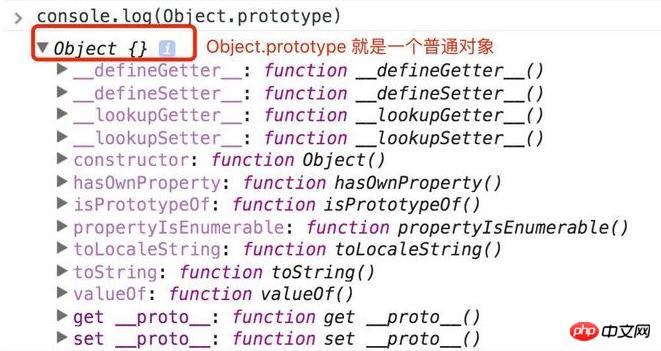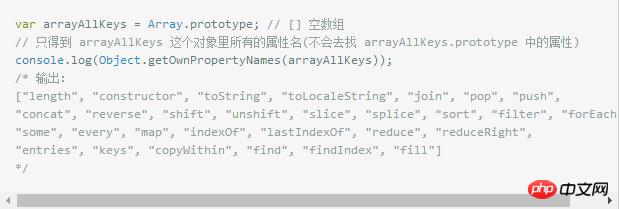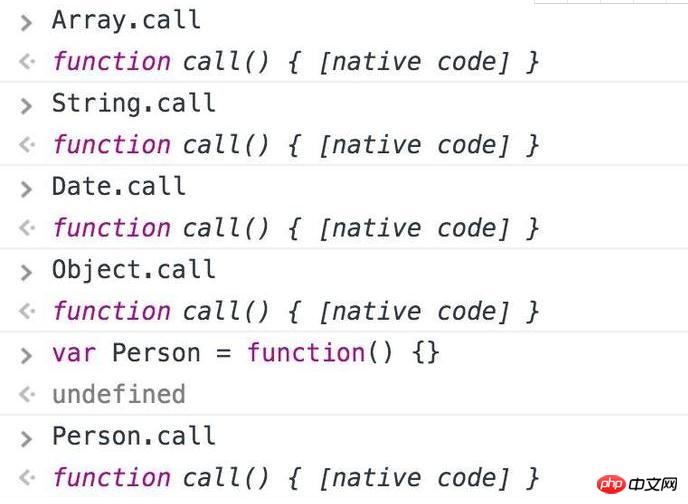详解JS原型和原型链(三)
这次接着上篇跟小编一起来看看JS原型和原型链以及注意事项有哪些,下面就是实战案例,一起来看一下。
七. 函数对象 (复习一下前面的知识点)
所有函数对象的proto都指向Function.prototype,它是一个空函数(Empty function)
Number.__proto__ === Function.prototype // true Number.constructor == Function //true Boolean.__proto__ === Function.prototype // true Boolean.constructor == Function //true String.__proto__ === Function.prototype // true String.constructor == Function //true // 所有的构造器都来自于Function.prototype,甚至包括根构造器Object及Function自身 Object.__proto__ === Function.prototype // true Object.constructor == Function // true // 所有的构造器都来自于Function.prototype,甚至包括根构造器Object及Function自身 Function.__proto__ === Function.prototype // true Function.constructor == Function //true Array.__proto__ === Function.prototype // true Array.constructor == Function //true RegExp.__proto__ === Function.prototype // true RegExp.constructor == Function //true Error.__proto__ === Function.prototype // true Error.constructor == Function //true Date.__proto__ === Function.prototype // true Date.constructor == Function //true
JavaScript中有内置(build-in)构造器/对象共计12个(ES5中新加了JSON),这里列举了可访问的8个构造器。剩下如Global不能直接访问,Arguments仅在函数调用时由JS引擎创建,Math,JSON是以对象形式存在的,无需new。它们的proto是Object.prototype。如下
Math.__proto__ === Object.prototype // true Math.construrctor == Object // true JSON.__proto__ === Object.prototype // true JSON.construrctor == Object //true
上面说的函数对象当然包括自定义的。如下
// 函数声明
function Person() {}
// 函数表达式
var Perosn = function() {}
console.log(Person.__proto__ === Function.prototype) // true
console.log(Man.__proto__ === Function.prototype) // true这说明什么呢?
** 所有的构造器都来自于 Function.prototype,甚至包括根构造器Object及Function自身。所有构造器都继承了·Function.prototype·的属性及方法。如length、call、apply、bind**
(你应该明白第一句话,第二句话我们下一节继续说,先挖个坑:))
Function.prototype也是唯一一个typeof XXX.prototype为 function的prototype。其它的构造器的prototype都是一个对象(原因第三节里已经解释过了)。如下(又复习了一遍):
console.log(typeof Function.prototype) // function console.log(typeof Object.prototype) // object console.log(typeof Number.prototype) // object console.log(typeof Boolean.prototype) // object console.log(typeof String.prototype) // object console.log(typeof Array.prototype) // object console.log(typeof RegExp.prototype) // object console.log(typeof Error.prototype) // object console.log(typeof Date.prototype) // object console.log(typeof Object.prototype) // object
噢,上面还提到它是一个空的函数,console.log(Function.prototype) 下看看(留意,下一节会再说一下这个)
知道了所有构造器(含内置及自定义)的__proto__都是Function.prototype,那Function.prototype的__proto__是谁呢?
相信都听说过JavaScript中函数也是一等公民,那从哪能体现呢?如下
console.log(Function.prototype.__proto__ === Object.prototype) // true
这说明所有的构造器也都是一个普通 JS 对象,可以给构造器添加/删除属性等。同时它也继承了Object.prototype上的所有方法:toString、valueOf、hasOwnProperty等。(你也应该明白第一句话,第二句话我们下一节继续说,不用挖坑了,还是刚才那个坑;))
最后Object.prototype的proto是谁?
Object.prototype.__proto__ === null // true
已经到顶了,为null。(读到现在,再回过头看第五章,能明白吗?)
八. Prototype
在 ECMAScript 核心所定义的全部属性中,最耐人寻味的就要数 prototype 属性了。对于 ECMAScript 中的引用类型而言,prototype 是保存着它们所有实例方法的真正所在。换句话所说,诸如 toString()和 valuseOf() 等方法实际上都保存在 prototype 名下,只不过是通过各自对象的实例访问罢了。
——《JavaScript 高级程序设计》第三版 P116
我们知道 JS 内置了一些方法供我们使用,比如:
对象可以用 constructor/toString()/valueOf() 等方法;
数组可以用 map()/filter()/reducer() 等方法;
数字可用用 parseInt()/parseFloat()等方法;
Why ???
当我们创建一个函数时:
var Person = new Object()
Person 是 Object 的实例,所以 Person 继承了Object 的原型对象Object.prototype上所有的方法:

Object.prototype
Object 的每个实例都具有以上的属性和方法。
所以我可以用 Person.constructor 也可以用 Person.hasOwnProperty。
当我们创建一个数组时:
var num = new Array()
num 是 Array 的实例,所以 num 继承了Array 的原型对象Array.prototype上所有的方法:

Array.prototype
Are you f***ing kidding me? 这尼玛怎么是一个空数组???
我们可以用一个 ES5 提供的新方法:Object.getOwnPropertyNames
获取所有(包括不可枚举的属性)的属性名不包括 prototy 中的属性,返回一个数组:

var arrayAllKeys = Array.prototype; // [] 空数组// 只得到 arrayAllKeys 这个对象里所有的属性名(不会去找 arrayAllKeys.prototype 中的属性)console.log(Object.getOwnPropertyNames(arrayAllKeys));
/* 输出:
["length", "constructor", "toString", "toLocaleString", "join", "pop", "push",
"concat", "reverse", "shift", "unshift", "slice", "splice", "sort", "filter", "forEach",
"some", "every", "map", "indexOf", "lastIndexOf", "reduce", "reduceRight",
"entries", "keys", "copyWithin", "find", "findIndex", "fill"]
*/
这样你就明白了随便声明一个数组,它为啥能用那么多方法了。
细心的你肯定发现了Object.getOwnPropertyNames(arrayAllKeys) 输出的数组里并没有 constructor/hasOwnPrototype等对象的方法(你肯定没发现)。
但是随便定义的数组也能用这些方法

var num = [1];console.log(num.hasOwnPrototype()) // false (输出布尔值而不是报错)
Why ???
因为Array.prototype 虽然没这些方法,但是它有原型对象(__proto__):
// 上面我们说了 Object.prototype 就是一个普通对象。 Array.prototype.__proto__ == Object.prototype
所以 Array.prototype 继承了对象的所有方法,当你用num.hasOwnPrototype()时,JS 会先查一下它的构造函数 (Array) 的原型对象 Array.prototype 有没有有hasOwnPrototype()方法,没查到的话继续查一下 Array.prototype 的原型对象 Array.prototype.__proto__有没有这个方法。
当我们创建一个函数时:
var f = new Function("x","return x*x;");
//当然你也可以这么创建 f = function(x){ return x*x }
console.log(f.arguments) // arguments 方法从哪里来的?
console.log(f.call(window)) // call 方法从哪里来的?
console.log(Function.prototype) // function() {} (一个空的函数)
console.log(Object.getOwnPropertyNames(Function.prototype));
/* 输出
["length", "name", "arguments", "caller", "constructor", "bind", "toString", "call", "apply"]
*/我们再复习第八小节这句话:
所有函数对象proto都指向 Function.prototype,它是一个空函数(Empty function)
嗯,我们验证了它就是空函数。不过不要忽略前半句。我们枚举出了它的所有的方法,所以所有的函数对象都能用,比如:

九. 复习一下
第八小节我们总结了:
所有函数对象的 __proto__ 都指向 Function.prototype,它是一个空函数(Empty function)
但是你可别忘了在第三小节我们总结的:
所有对象的 __proto__ 都指向其构造器的 prototype
我们下面再复习下这句话。
先看看 JS 内置构造器:
var obj = {name: 'jack'}
var arr = [1,2,3]
var reg = /hello/g
var date = new Date
var err = new Error('exception')
console.log(obj.__proto__ === Object.prototype) // true
console.log(arr.__proto__ === Array.prototype) // true
console.log(reg.__proto__ === RegExp.prototype) // true
console.log(date.__proto__ === Date.prototype) // true
console.log(err.__proto__ === Error.prototype) // true再看看自定义的构造器,这里定义了一个 Person:
function Person(name) {
this.name = name;
}
var p = new Person('jack')
console.log(p.__proto__ === Person.prototype) // truep 是 Person 的实例对象,p 的内部原型总是指向其构造器 Person 的原型对象 prototype。
每个对象都有一个 constructor 属性,可以获取它的构造器,因此以下打印结果也是恒等的:
function Person(name) {
this.name = name
}
var p = new Person('jack')
console.log(p.__proto__ === p.constructor.prototype) // true上面的Person没有给其原型添加属性或方法,这里给其原型添加一个getName方法:
function Person(name) {
this.name = name
}
// 修改原型
Person.prototype.getName = function() {}
var p = new Person('jack')
console.log(p.__proto__ === Person.prototype) // true
console.log(p.__proto__ === p.constructor.prototype) // true可以看到p.__proto__与Person.prototype,p.constructor.prototype都是恒等的,即都指向同一个对象。
如果换一种方式设置原型,结果就有些不同了:
function Person(name) {
this.name = name
}
// 重写原型Person.prototype = {
getName: function() {}
}
var p = new Person('jack')
console.log(p.__proto__ === Person.prototype) // true
console.log(p.__proto__ === p.constructor.prototype) // false这里直接重写了 Person.prototype(注意:上一个示例是修改原型)。输出结果可以看出p.__proto__仍然指向的是Person.prototype,而不是p.constructor.prototype。
这也很好理解,给Person.prototype赋值的是一个对象直接量{getName: function(){}},使用对象直接量方式定义的对象其构造器(constructor)指向的是根构造器Object,Object.prototype是一个空对象{},{}自然与{getName: function(){}}不等。如下:
var p = {}
console.log(Object.prototype) // 为一个空的对象{}
console.log(p.constructor === Object) // 对象直接量方式定义的对象其constructor为Objectconsole.log(p.constructor.prototype === Object.prototype) // 为true,
不解释(๑ˇ3ˇ๑)十. 原型链(再复习一下:)
下面这个例子你应该能明白了!
function Person(){
}var person1 = new Person();
console.log(person1.__proto__ === Person.prototype); // true
console.log(Person.prototype.__proto__ === Object.prototype) //true
console.log(Object.prototype.__proto__) //null
Person.__proto__ == Function.prototype; //true
console.log(Function.prototype)// function(){} (空函数)
var num = new Array()console.log(num.__proto__ == Array.prototype) // true
console.log( Array.prototype.__proto__ == Object.prototype) // true
console.log(Array.prototype) // [] (空数组)
console.log(Object.prototype.__proto__) //null
console.log(Array.__proto__ == Function.prototype)// true疑点解惑:
Object.__proto__ === Function.prototype // true
Object 是函数对象,是通过new Function()创建的,所以Object.__proto__指向Function.prototype。(参照第八小节:「所有函数对象的__proto__都指向Function.prototype」)
Function.__proto__ === Function.prototype // true
Function 也是对象函数,也是通过new Function()创建,所以Function.__proto__指向Function.prototype。
自己是由自己创建的,好像不符合逻辑,但仔细想想,现实世界也有些类似,你是怎么来的,你妈生的,你妈怎么来的,你姥姥生的,……类人猿进化来的,那类人猿从哪来,一直追溯下去……,就是无,(NULL生万物)
正如《道德经》里所说“无,名天地之始”。
Function.prototype.__proto__ === Object.prototype //true
其实这一点我也有点困惑,不过也可以试着解释一下。
Function.prototype是个函数对象,理论上他的__proto__应该指向 Function.prototype,就是他自己,自己指向自己,没有意义。
JS一直强调万物皆对象,函数对象也是对象,给他认个祖宗,指向Object.prototype。Object.prototype.__proto__ === null,保证原型链能够正常结束。
十一 总结
原型和原型链是JS实现继承的一种模型。
原型链的形成是真正是靠__proto__ 而非prototype
要深入理解这句话,我们再举个例子,看看前面你真的理解了吗?
var animal = function(){}; var dog = function(){};
animal.price = 2000;
dog.prototype = animal; var tidy = new dog(); console.log(dog.price) //undefined
console.log(tidy.price) // 2000这里解释一下:
var dog = function(){};
dog.prototype.price = 2000; var tidy = new dog(); console.log(tidy.price); // 2000
console.log(dog.price); //undefined
var dog = function(){}; var tidy = new dog();
tidy.price = 2000; console.log(dog.price); //undefined这个明白吧?想一想我们上面说过这句话:
实例(tidy)和 原型对象(dog.prototype)存在一个连接。不过,要明确的真正重要的一点就是,这个连接存在于实例(tidy)与构造函数的原型对象(dog.prototype)之间,而不是存在于实例(tidy)与构造函数(dog)之间。
聪明的你肯定想通了吧 :)
Atas ialah kandungan terperinci 详解JS原型和原型链(三). Untuk maklumat lanjut, sila ikut artikel berkaitan lain di laman web China PHP!

Alat AI Hot

Undresser.AI Undress
Apl berkuasa AI untuk mencipta foto bogel yang realistik

AI Clothes Remover
Alat AI dalam talian untuk mengeluarkan pakaian daripada foto.

Undress AI Tool
Gambar buka pakaian secara percuma

Clothoff.io
Penyingkiran pakaian AI

AI Hentai Generator
Menjana ai hentai secara percuma.

Artikel Panas

Alat panas

Notepad++7.3.1
Editor kod yang mudah digunakan dan percuma

SublimeText3 versi Cina
Versi Cina, sangat mudah digunakan

Hantar Studio 13.0.1
Persekitaran pembangunan bersepadu PHP yang berkuasa

Dreamweaver CS6
Alat pembangunan web visual

SublimeText3 versi Mac
Perisian penyuntingan kod peringkat Tuhan (SublimeText3)

Topik panas
 1377
1377
 52
52
 Penjelasan terperinci tentang mendapatkan hak pentadbir dalam Win11
Mar 08, 2024 pm 03:06 PM
Penjelasan terperinci tentang mendapatkan hak pentadbir dalam Win11
Mar 08, 2024 pm 03:06 PM
Sistem pengendalian Windows ialah salah satu sistem pengendalian yang paling popular di dunia, dan versi baharunya Win11 telah menarik perhatian ramai. Dalam sistem Win11, mendapatkan hak pentadbir adalah operasi penting Hak pentadbir membolehkan pengguna melakukan lebih banyak operasi dan tetapan pada sistem. Artikel ini akan memperkenalkan secara terperinci cara mendapatkan kebenaran pentadbir dalam sistem Win11 dan cara mengurus kebenaran dengan berkesan. Dalam sistem Win11, hak pentadbir dibahagikan kepada dua jenis: pentadbir tempatan dan pentadbir domain. Pentadbir tempatan mempunyai hak pentadbiran penuh ke atas komputer tempatan
 Penjelasan terperinci tentang operasi bahagian dalam Oracle SQL
Mar 10, 2024 am 09:51 AM
Penjelasan terperinci tentang operasi bahagian dalam Oracle SQL
Mar 10, 2024 am 09:51 AM
Penjelasan terperinci tentang operasi bahagi dalam OracleSQL Dalam OracleSQL, operasi bahagi ialah operasi matematik yang biasa dan penting, digunakan untuk mengira hasil pembahagian dua nombor. Bahagian sering digunakan dalam pertanyaan pangkalan data, jadi memahami operasi bahagian dan penggunaannya dalam OracleSQL adalah salah satu kemahiran penting untuk pembangun pangkalan data. Artikel ini akan membincangkan pengetahuan berkaitan operasi bahagian dalam OracleSQL secara terperinci dan menyediakan contoh kod khusus untuk rujukan pembaca. 1. Operasi bahagian dalam OracleSQL
 Penjelasan terperinci tentang peranan dan penggunaan pengendali modulo PHP
Mar 19, 2024 pm 04:33 PM
Penjelasan terperinci tentang peranan dan penggunaan pengendali modulo PHP
Mar 19, 2024 pm 04:33 PM
Operator modulo (%) dalam PHP digunakan untuk mendapatkan baki pembahagian dua nombor. Dalam artikel ini, kami akan membincangkan peranan dan penggunaan pengendali modulo secara terperinci, dan memberikan contoh kod khusus untuk membantu pembaca memahami dengan lebih baik. 1. Peranan pengendali modulo Dalam matematik, apabila kita membahagi integer dengan integer lain, kita mendapat hasil bagi dan baki. Sebagai contoh, apabila kita membahagi 10 dengan 3, hasil bahagi ialah 3 dan selebihnya ialah 1. Operator modulo digunakan untuk mendapatkan baki ini. 2. Penggunaan operator modulo Dalam PHP, gunakan simbol % untuk mewakili modulus
 Penjelasan terperinci tentang fungsi sistem panggilan sistem linux().
Feb 22, 2024 pm 08:21 PM
Penjelasan terperinci tentang fungsi sistem panggilan sistem linux().
Feb 22, 2024 pm 08:21 PM
Penjelasan terperinci tentang fungsi sistem panggilan sistem Linux() Panggilan sistem ialah bahagian yang sangat penting dalam sistem pengendalian Linux Ia menyediakan cara untuk berinteraksi dengan kernel sistem. Antaranya, fungsi system() adalah salah satu fungsi panggilan sistem yang biasa digunakan. Artikel ini akan memperkenalkan penggunaan fungsi system() secara terperinci dan memberikan contoh kod yang sepadan. Konsep Asas Panggilan Sistem Panggilan sistem ialah satu cara untuk atur cara pengguna berinteraksi dengan kernel sistem pengendalian. Program pengguna meminta sistem pengendalian dengan memanggil fungsi panggilan sistem
 Penjelasan terperinci tentang perintah curl Linux
Feb 21, 2024 pm 10:33 PM
Penjelasan terperinci tentang perintah curl Linux
Feb 21, 2024 pm 10:33 PM
Penjelasan terperinci tentang perintah curl Linux Ringkasan: curl ialah alat baris arahan yang berkuasa yang digunakan untuk komunikasi data dengan pelayan. Artikel ini akan memperkenalkan penggunaan asas perintah curl dan memberikan contoh kod sebenar untuk membantu pembaca memahami dan menggunakan arahan dengan lebih baik. 1. Apakah curl? curl ialah alat baris arahan yang digunakan untuk menghantar dan menerima pelbagai permintaan rangkaian. Ia menyokong berbilang protokol, seperti HTTP, FTP, TELNET, dll., dan menyediakan fungsi yang kaya, seperti muat naik fail, muat turun fail, penghantaran data, proksi
 Tutorial JavaScript Mudah: Cara Mendapatkan Kod Status HTTP
Jan 05, 2024 pm 06:08 PM
Tutorial JavaScript Mudah: Cara Mendapatkan Kod Status HTTP
Jan 05, 2024 pm 06:08 PM
Tutorial JavaScript: Bagaimana untuk mendapatkan kod status HTTP, contoh kod khusus diperlukan: Dalam pembangunan web, interaksi data dengan pelayan sering terlibat. Apabila berkomunikasi dengan pelayan, kami selalunya perlu mendapatkan kod status HTTP yang dikembalikan untuk menentukan sama ada operasi itu berjaya dan melaksanakan pemprosesan yang sepadan berdasarkan kod status yang berbeza. Artikel ini akan mengajar anda cara menggunakan JavaScript untuk mendapatkan kod status HTTP dan menyediakan beberapa contoh kod praktikal. Menggunakan XMLHttpRequest
 Analisis terperinci laluan pembelajaran bahasa C
Feb 18, 2024 am 10:38 AM
Analisis terperinci laluan pembelajaran bahasa C
Feb 18, 2024 am 10:38 AM
Sebagai bahasa pengaturcaraan yang digunakan secara meluas dalam bidang pembangunan perisian, bahasa C adalah pilihan pertama bagi ramai pengaturcara pemula. Mempelajari bahasa C bukan sahaja dapat membantu kita mewujudkan pengetahuan asas pengaturcaraan, tetapi juga meningkatkan kebolehan menyelesaikan masalah dan pemikiran kita. Artikel ini akan memperkenalkan secara terperinci pelan hala tuju pembelajaran bahasa C untuk membantu pemula merancang proses pembelajaran mereka dengan lebih baik. 1. Belajar tatabahasa asas Sebelum mula mempelajari bahasa C, kita perlu memahami peraturan tatabahasa asas bahasa C terlebih dahulu. Ini termasuk pembolehubah dan jenis data, operator, pernyataan kawalan (seperti pernyataan if,
 Ketahui lebih lanjut tentang Promise.resolve()
Feb 18, 2024 pm 07:13 PM
Ketahui lebih lanjut tentang Promise.resolve()
Feb 18, 2024 pm 07:13 PM
Penjelasan terperinci Promise.resolve() memerlukan contoh kod khusus Promise ialah mekanisme dalam JavaScript untuk mengendalikan operasi tak segerak. Dalam pembangunan sebenar, selalunya perlu untuk memproses beberapa tugas tak segerak yang perlu dilaksanakan mengikut turutan, dan kaedah Promise.resolve() digunakan untuk mengembalikan objek Promise yang telah dipenuhi. Promise.resolve() ialah kaedah statik kelas Promise, yang menerima a




